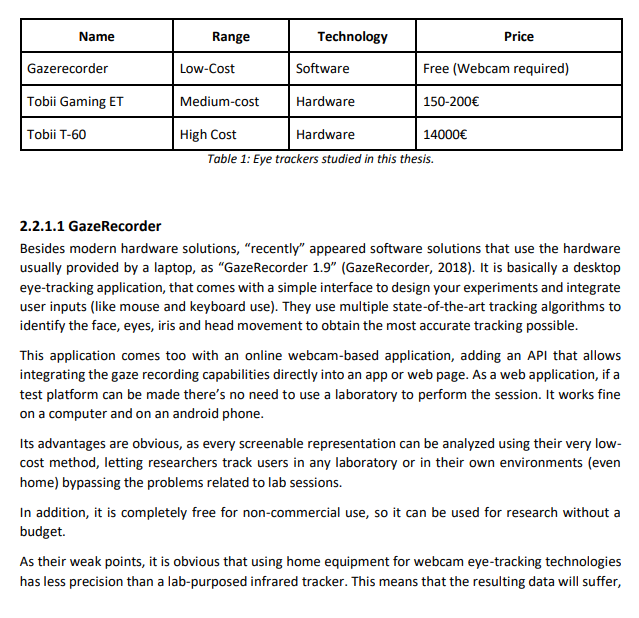In this thesis, the different methodologies for analyzing the UX experience are explored from a usercentered perspective. These classical and well-founded methodologies only allow the extraction of cognitive data, that is, the data that the user is capable of consciously communicating. The objective of this thesis is to propose a methodology that uses the extraction of biometric data to complement the aforementioned cognitive information with emotional (and formal) data.
This thesis is not only theoretical, since the proposed model (and its evolution) is complemented with the different tests, validations, and investigations in which they have been applied, often in conjunction with research groups from other areas with success.
https://www.tdx.cat/bitstream/handle/10803/673244/Tjvg1de1.pdf?sequence=1&isAllowed=y

Besides modern hardware solutions, “recently” appeared software solutions that use the hardware usually provided by a laptop, as “GazeRecorder 1.9” (GazeRecorder, 2018). It is basically a desktop eye-tracking application, that comes with a simple interface to design your experiments and integrate user inputs (like mouse and keyboard use). They use multiple state-of-the-art tracking algorithms to identify the face, eyes, iris and head movement to obtain the most accurate tracking possible. This application comes too with an online webcam-based application, adding an API that allows integrating the gaze recording capabilities directly into an app or web page. As a web application, if a
test platform can be made there’s no need to use a laboratory to perform the session. It works fine on a computer and on an android phone.
Its advantages are obvious, as every screenable representation can be analyzed using their very lowcost method, letting researchers track users in any laboratory or in their own environments (even home) bypassing the problems related to lab sessions. In addition, it is completely free for non-commercial use, so it can be used for research without a budget.
As their weak points, it is obvious that using home equipment for webcam eye-tracking technologies has less precision than a lab-purposed infrared tracker. This means that the resulting data will suffer, especially with lower webcam resolutions and poor lighting conditions. Lower resolutions mean that not many of the webcams in the market provide HD (1920 x 1080 pixels), being the normal 480px. This implies that the eye will appear as one group, being incapable of differentiating pupil and iris (as infrared cameras do). In the same way, as webcams do not come with their light source, they will need a proper external light that provides the contrast needed to detect eye position against the rest of the face.